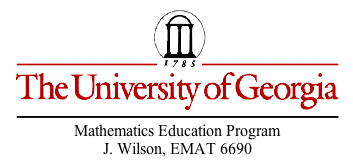
William Plummer - Essay #1
The Link Between Binomial Expansion and Probability
Binomials or any other two term quantities with integer exponents happen frequently in mathematics.
The first few powers are as follows:
(a+b)0 = 1
(a+b)1 = a+b
(a+b)2 = a2 +
2ab + b2
(a+b)3 = a3 +
3a2b + 3ab2 + b3
There are some patterns observed as we increase the integer exponent of (a+b)n.
--First, for the expansion of (a+b)n, there are always n+1 terms.
--Second, the exponent of a in the first term is n and then decreases by 1 in each succeeding term all the way down to 0 in the last term.
--Finally, the exponent of b in the first term is 0 and then increases by 1 in each succeeding term all the way up to n in the last term.
The expansion of (a+b)n is expressed by the Binomial Theorem:
Where
is the symbolic representation
of the coefficients of each term in the binomial expansion.
The
coefficients can be calculated as follows:

The coefficients
of the binomial expansion can be written in rows for each integer from 0 to n
as follows
The coefficients written in this manner form a triangle shape of values
and is referred to as Pascal’s Triangle.
There are
certain patterns observed in Pascal’s Triangle:
1.) The
first coefficient and the last coefficient in each row are equal to 1
2.) The
coefficients are symmetric about the median of each row
Symbolically,
this is written as

3.) Finally, for each row in Pascal’s Triangle where n≥2, each coefficient, except for the first and the last, can be obtained by adding the coefficients above it and to the left and right.
Symbolically, this is written as

Now
earlier we stated that the coefficients in each term can be calculated as
follows:

This
equation should be familiar as the formula to determine the number of
combinations of n items taken r at a time.
So it
follows that the coefficients in each term can be calculated using the equation
for combinations:

But
is there a way we can use the binomial theorem to find probability?
Example problem:
A two-sided coin is tossed 6 times with the possibility of
obtaining a heads or tails.
What is the probability of getting 4 heads?
The two
possibilities can be written as a binomial
(H+T)n
where n is the number
of times the coin is tossed.
So if the
coin is tossed 6 times, we have the following binomial
(H+T)6
along with its
binomial expansion.
1
H6
T0 + 6
H5
T1 + 15 H4
T2 + 20 H3
T3 + 15
H2
T4 + 6
H1
T5 + 1 H0
T6
The
coefficients of the binomial expansion represent the number of possibilities
(or combinations) of the number of heads and tails (represented by the
exponents on H and T) that follow the coefficient.
Number of
ways a coin can be tossed and obtain
6 Heads (and 0 Tails) = 1
5 Heads (and 1 Tail) = 6
4 Heads (and 2 Tails) = 15
3 Heads (and 3 Tails) = 20
2 Heads (and 4 Tails) = 15
1 Head (and 5 Tails) = 6
0 Heads (and 6 Tails) = 1
In
general, the sum of the coefficients of a binomial expansion (a+b)n = 2n
This sum
represents the total number of possibilities when tossing a coin 6 times.
In this
case the sum of the coefficients = (1 + 6 + 15 + 20 + 15 + 6 + 1) = 26 = 64

Summary
Binomial expansion using the Binomial Theorem and Pascal's Triangle as well as finding probability using combinations and permutations are topics taught in 9th grade GPS Math I. This connection between the two concepts should be taught to reinforce understanding of both. At minimum, it would serve as an excellent enrichment or differentiation for gifted and higher performing students in GPS Math I.


